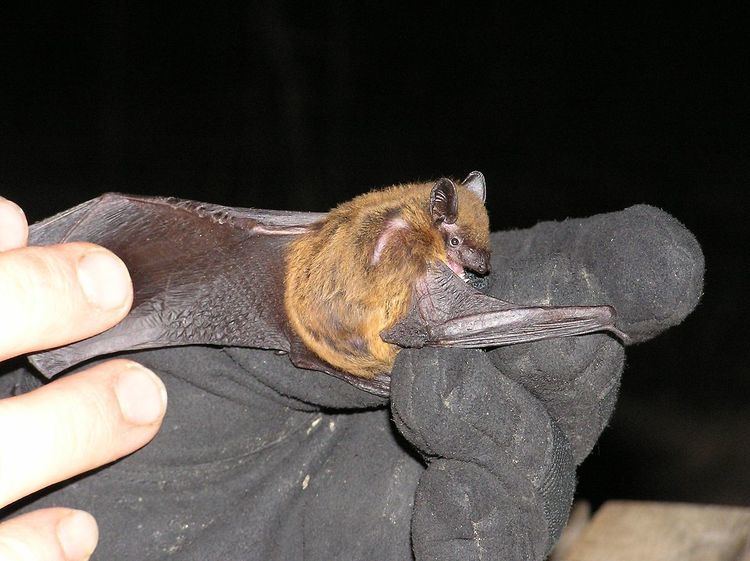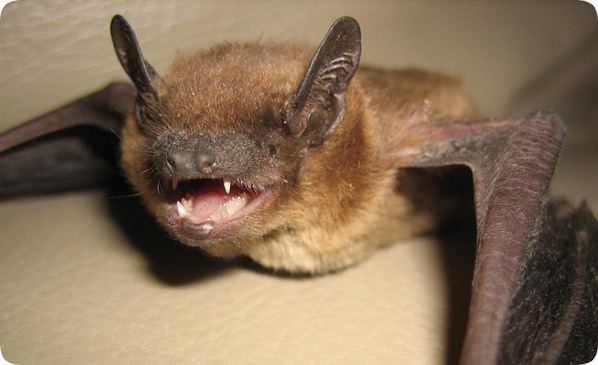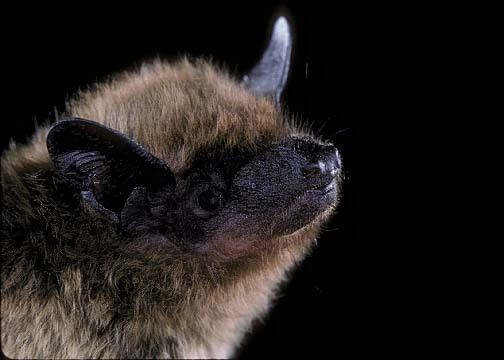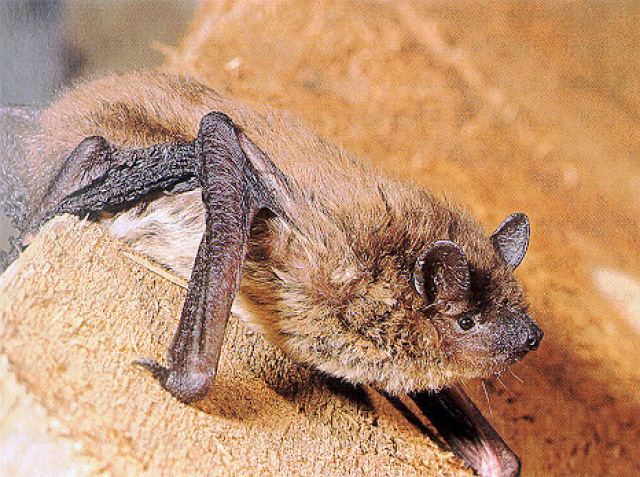Order Chiroptera Higher classification Evening bats | Phylum Chordata Family Vespertilionidae Scientific name Nycticeius humeralis Rank Species | |
 | ||
Similar Evening bats, Bat, Eastern red bat, Eastern pipistrelle, Silver‑haired bat | ||
Evening bat
Baby evening bats
Description

The evening bat (Nycticeius humeralis) is a species of bat in the vesper bat family, Vespertilionidae, that is native to North America. It is a small bat (7–15 grams) found throughout much of the midwestern and eastern United States. The tip of each dorsal hair is a light gray, and one- to two-thirds of the basal is dark brown. Though there have been some cases of white pelage, the majority of the population is mostly brown in color. The evening bat was originally thought to be a juvenile big brown bat, due to its physical resemblance but smaller size. After careful evaluation, it was discovered that the evening bat was its own species.
Contents
Echolocation

Evening bats are considered microchiropterans which means they have some sort of facial ornamentation. These bats with facial ornamentation tend to be more efficient in echolocation, whereas their counterparts, megachiropterans, abandon or use less of this hunting/communication method and rely more on visual and olfactory senses. Because they're microchiropterans, the evening bat is very efficient at echolocating. In bats, echolocation originates from the larynx.
Morphology

These bats have a massive skull in proportion to their bodies and have a large, strong jaw. With a stronger jaw, it is more capable of crunching down on insects such as beetles or moths. Their teeth have relatively precise occlusion with large incisors on both the maxilla as well as the mandible. Their eyes are on the sides of their head, giving them monocular vision. In many cases, this could be considered evolutionary un-advantageous; However, because the evening bat is nocturnal and echolocates, it does not rely much on sight. Their tails, ears, and wings are quite thick and leathery for being a smaller bat. In addition, microchiropterans do not have a claw on their second finger in comparison to megachiropterans.
Reproduction

Though it is more common for N. Humeralis to nurse their own offspring, in a relatively recent study done by G.S. Wilkinson in 1992 it has been observed in numerous colonies that there is a small portion of offspring that are nursed by un-related lactating females. Lactation is one of the most expensive parts of reproduction in mammals, thus, it is usually not beneficial to nurse more than needed. As the study goes on to describe, the average body mass of the lactating female bats went down significantly during their highest rates of lactation and demand whereas when the pups began to grow older and learn to fly, the female body mass began to increase; However, interestingly, this is when communal nursing began to become more apparent.

Evening bats are generally not the typical bat that comes to mind when people think of these organisms. While many of their behaviors are typical to most bats, the evening bat prefers to roost in trees or can even be found roosting in man-made structures. Only one individual has been found roosting in a cave. There have also been numerous studies of evening bats in which breeding behaviors in colonies that took to roosting in household attics were observed. This led to the discovery of the average amount of females communal nursing in a single colony. Another interesting phenomenon that Wilkinson observed was that male pups seem to have a higher mortality rate than female pups. Males either died or disappeared when they were just starting to hunt on their own and when their mothers were at their lowest body mass.

Though little is generally known about when (or where) evening bats mate, they usually give birth between April and May and nurse their young anywhere from 24 to 42 weeks after birth, usually vacating maternity roosts between September and November. In this time, the pups will begin to fly when they are around 22 weeks old and begin to become more independent. This is what allows the mother to gain back the body mass that she lost. From birth to 22 weeks, on average, the mother will lose about one gram of body mass. That is a significant loss of body mass for a 7-15 gram organism.
Diet
These bats feed heavily on beetles (Coleoptera), but they also eat moths (Lepidoptera) and to a lesser extent, flies (Diptera) and other insects. In fact, evening bats are categorized as "beetle specialists". Though their relative, The Great Evening Bat, enjoys eating birds (among beetles and moths), this smaller, more distant relative prefers to stay insectivorous. Relating back to echolocation, the evening bats use the most evolutionary advantageous method to hunt at night for these insects. With the accuracy of location that comes from perceiving the echos off of a moth or beetle, echolocation is the best method to "see" these movements and organisms in the dark.
In addition, due to the significant increase in body mass (fat storage gained from foraging in summer) around autumn, it is presumable that these bats enter torpor for the winter; However, there are studies that suggest that instead of these bats entering torpor for the winter, they migrate to a warmer climate. At this time, it is unknown which hypothesis is correct.
Distribution
The evening bat is generally thought to be migratory but recent work suggests that some individuals may be non-migratory, even near the northern edge of their range. During winter, individuals continue to roost in tree cavities or buildings and they may forage on warm days. Colonies are generally small in trees but groups can reach nearly 1,000 individuals, especially in buildings or other man-made structures.
Although evening bats are generally found in the Eastern US, in recent years populations have been discovered expanding west and north into the midwestern states and parts of Canada. It is likely that this was facilitated by a "corridor" opening from their original habitat to areas that have climatically adjusted to be more habitable for this species, or a new way of transportation (like air corridors) was facilitated in a climate change. In this case, it is thought to be a "riparian corridor". When corridors like these "open up", they become an ecological bridge where numerous species can venture to habitats that otherwise would have been out of their distribution range. We can see examples of these corridors with the North American Flyways, the Pacific Ocean Corridors, and many other examples, providing a good basis for this theory of the evening bat's newest migrations and distribution.
Fun fact: In July 2016, the evening bat was discovered living in Minnesota, the first time in more than 100 years a new bat species was identified in that state.
